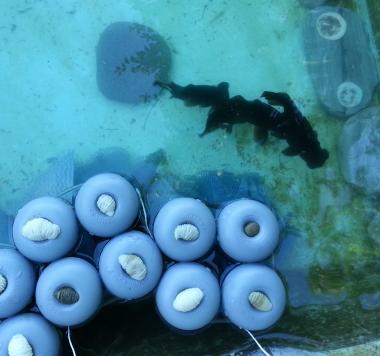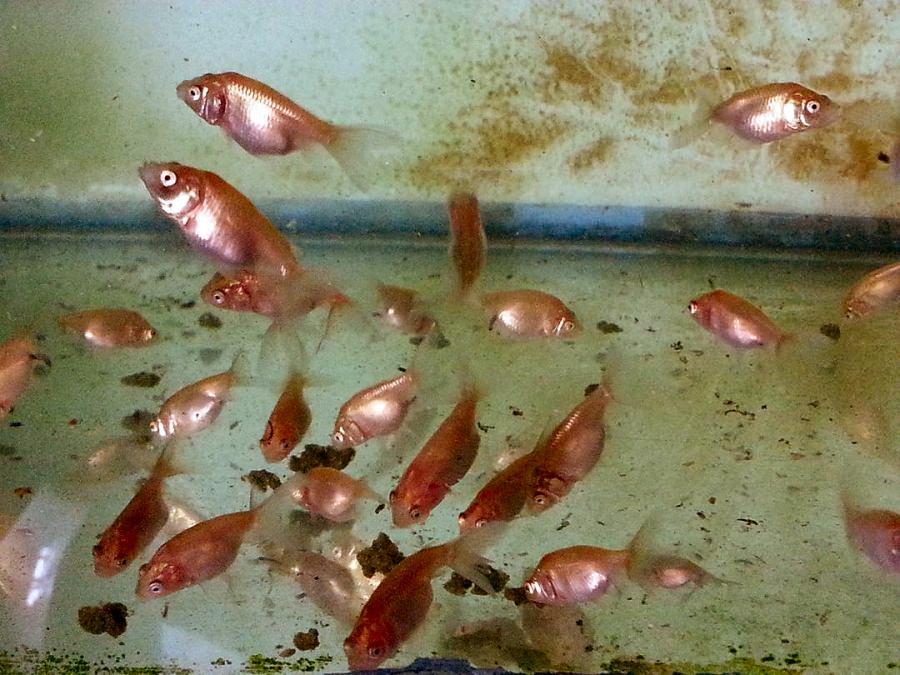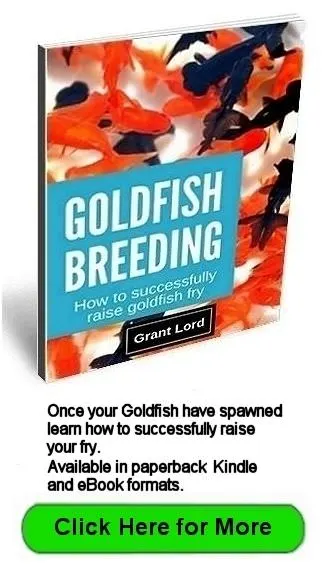- Home
- Breeding
Goldfish Breeding : Secrets of How to Successfully Breed Goldfish
Goldfish Breeding Overview
 Black Moor males chasing female into spawning mops
Black Moor males chasing female into spawning mopsGoldfish breeding is a natural progression after you have kept Goldfish successfully for a while.
Last updated: 06-19-2023 by Grant Lord
Although you can get a great deal of pleasure raising Goldfish you have purchased, this doesn’t compare with the satisfaction of spawning them yourself and raising the very best fry through to adulthood.
If you have some particularly nice specimens they will need to be replaced one day. On the other side of the coin, after reading about the ideal standards for your Goldfish variety, you may now realize yours aren’t of a very high quality. Unless you purchase your fish directly from a breeder, those that are commercially raised for sale in pet shops are never going to be high quality (unless you are very lucky).
If you can, purchase your Goldfish from establishments that specialize in selling Goldfish and tropical fish. These shops know far more than the average pet shop.
Use the guides in this website to help you select the best quality fish from whatever source you choose.
At the end of the day, the best way to improve the quality of your stock is to breed your own.
Because the subject of Goldfish breeding covers a large amount of information, I have broken the process into four stages:
- An Overview, which you are reading now
- Goldfish pre-spawning preparation which talks about male/female differences and conditioning the breeders
- How to breed Goldfish which discusses when where and how to breed your Goldfish, and finally
- What if spawning doesn't go to plan? Here we list some of the reasons why Goldfish don’t spawn and tricks used by experienced breeders to encourage spawning.
Once you have successfully bred you Goldfish, you can then head over to the section that takes you through the steps on how to raise Goldfish fry.
So, let’s begin…
Goldfish Breeding Equipment
To breed Goldfish successfully you need lots of room. By room I mean water volume.
For the first week or two you only need a spare tank or two to hatch the fry (Goldfish babies) in and get them to a size when you can start selecting the ones you want to keep. After that the requirement for room increases dramatically unless you start culling down the number of fry to suit the size of your setup.
It is assumed the adult fish are already in their own pond or tank being conditioned with high quality and live foods.
Here is a list of equipment needed to breed a
pair or trio (one female, two males) of average sized Goldfish with a body
length of around 3 inches (75mm). At this size as a minimum you should expect 500 fry, but a well-conditioned trio could easily produce up to 3,000.
- An aquarium of at least 30 gallons (114-140 liters) with a height of around 12 inches (300mm), or a pond/container that will hold around 40 gallons (150-180 liters) when filled 6 inches (150mm) deep.
- A 15 gallon (60-70 liter) hatching or fry tank, two if the fry hatch numbers are expected to be greater than 2,000. You could use the breeding tank or pond/container to hatch the fry in, but it will need to be heated if overnight water temperatures will fall below 65oF (18oC), and there are also parasite factors to consider as well.
- Heater(s) for the hatching tank(s) and brine shrimp hatchery
- Air pump and tubing for the hatching tank(s) and brine shrimp hatchery
- Sponge filter(s) for the fry tank
- Spawning mops to catch the Goldfish eggs
- Brine shrimp eggs and hatchery
This setup is suitable for breeding Goldfish in and hatching the eggs.
Once the fry are free swimming and feeding, they can stay in the hatching tank for about another week until they will need to be spread out into more tanks or ponds. Breeding Goldfish requires a lot of room.
What is the Best Time to Breed Goldfish?
Goldfish can be induced to spawn at any time of the year, but trying to manage a large spawning indoors using only heated tanks means you would need a large amount of space for many tanks.
Goldfish fry grow very quickly, and require a lot of room if they are to grow properly.
The best time to breed Goldfish is in the natural breeding season which is spring, when temperatures are on the rise, natural live foods are available, and outdoor ponds can be used for growing.
How Much Time Does It Take to Breed Goldfish?
Goldfish breeding takes place over a few hours. Raising the fry to a good size before winter takes 5-6 months.
During those months the fry and juveniles will need to be fed 2-3 times daily, culled at regular intervals to ensure the best individuals you intend to keep have adequate room to grow, and water changes, lots of water changes to keep the fry growing as fast as possible.
The most critical time is the first 1-2 months after hatching. This is when the fry are growing their fastest. The fry must be given the best possible conditions and be fed high quality foods during this time otherwise they will fail to reach their full potential.
I hope you are getting the idea that Goldfish breeding takes a lot of commitment if you want to do it properly.
At What Age do Goldfish Breed?
Goldfish will spawn at 1 year, but the ideal age is between two and four years. Fish younger than this tend to throw small numbers of small eggs. Small eggs produce small fry which is not desirable. Fish older than this may spawn a large number of large eggs, but the number of infertile eggs and deformed fry is high.
Unless you are lucky enough to have purchased exceptional parents, you will have to make do with what you have. It will just take a little longer to produce that champion fish.
To learn more about selecting breeders, go to the Choosing Goldfish for Breeding page.
The Grandparents Affect Fry Quality
An interesting fact when breeding Goldfish is that you are actually breeding the parents of your selected breeders. This shows itself in the quality of the fry. Any faults in the grandparents seem to miss a generation and then show up worse in the fry.
It's called the second generation throw-back factor.
An example of this was when I was given a pair of Water Bubble Eyes to breed by a Goldfish wholesaler.
The female wasn’t too bad, good even-sized water bubbles, with a reasonably smooth back. The male however was a disaster. He had a long body with a dorsal fin. No serious breeder would ever consider breeding either of these fish. However, because of supply difficulties, I had no option.
The parents produced large numbers of high quality fry.
You can guess what happened when I bred the fry…large numbers of low quality fry, even though the parents had been selected from thousands of fry and were of the highest quality.
The poor quality of the grandparents came through strongly.
Goldfish Always Try To Revert Back To Type
What I mean by this is Goldfish will always try and revert back to that drab single tailed, slim bodied ancestor with a dorsal fin that all Goldfish came from. In every spawning, there will be a number of fry exhibiting very few of the desired traits of the parents (or grandparents). If the fry should have two caudal fins, some will have one. If the fry should have no dorsal fins, some will have partial fins or spikes.
So it goes without saying, but I will say it anyway…NEVER breed different varieties together.
I will repeat that again, it’s important… NEVER breed different varieties together. It is hard enough raising quality fry using exceptional parents without producing a spawn of rubbish that nobody wants. You may as well spend your time raising high quality stock you will be proud to show anyone.
We haven’t spent much time discussing Goldfish breeding yet, but as you now understand, a lot of groundwork needs to be done before breeding can commence.
To learn how to identify the differences between the sexes and the pre-spawning conditioning required before you start your Goldfish breeding preparation, click here.
If you have already observed your Goldfish breeding and have collected some eggs, go straight to the page on how to raise goldfish fry.





